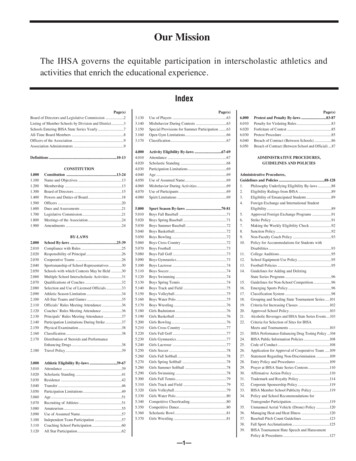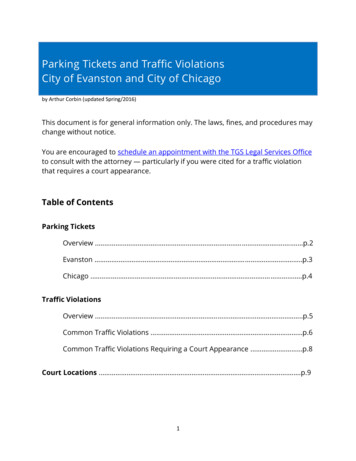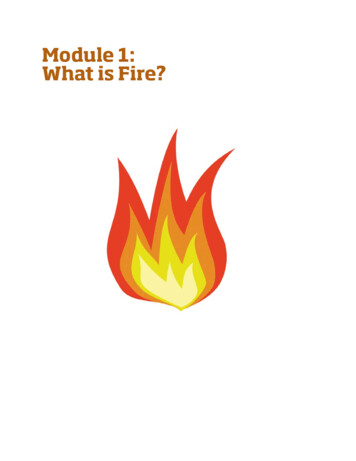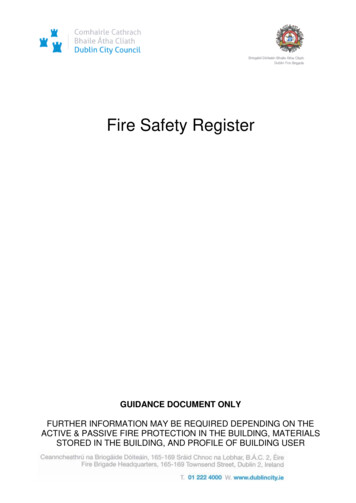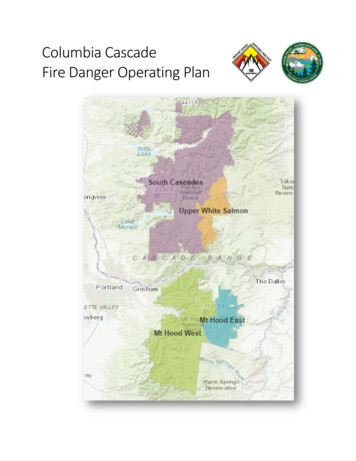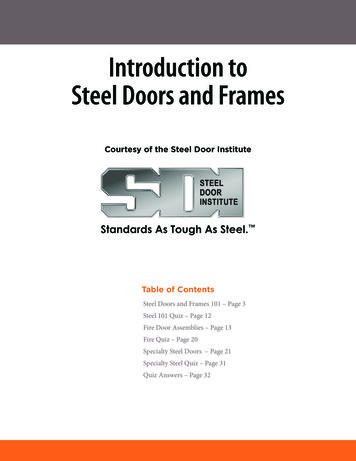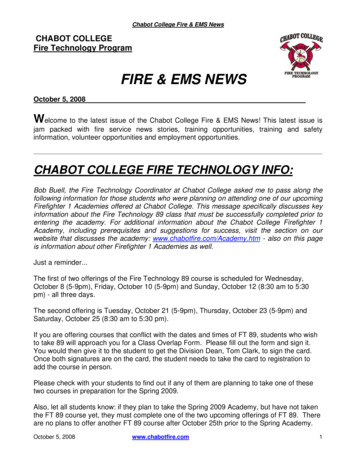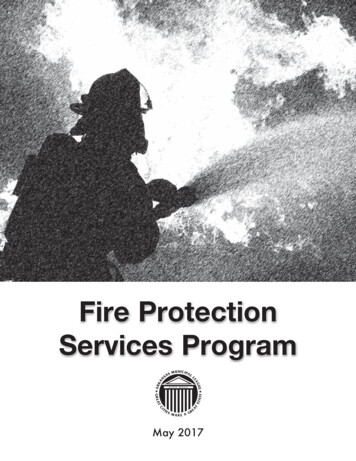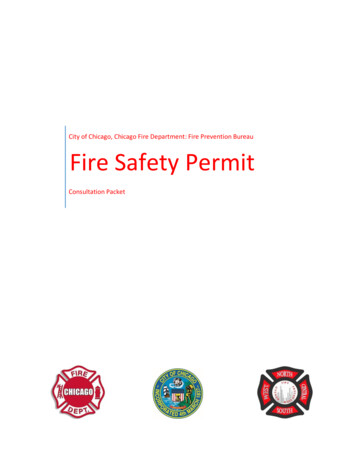
Transcription
City of Chicago, Chicago Fire Department: Fire Prevention BureauFire Safety PermitConsultation Packet
CITY OF CHICAGOCHICAGO FIRE DEPARTMENTFIRE PREVENTION BUREAUMOBILE FOOD VEHICLES (MFV)FIRE SAFETY PERMIT PROCESSSTATEMENT OF CFD POLICY REGARDING FIRE SAFETY PERMIT APPLICATIONSAll mobile food vehicles that will use a GASOLINE, DIESEL OR PROPANE SUPPLIED ELECTRIC GENERATOR;PROPANE GAS OR COMPRESSED NATURAL GAS; TYPES I OR II EXHAUST HOOD AND/OR FIRESUPPRESSION SYSTEM must apply for a fire safety permit issued by the Chicago Fire Department, FirePrevention Bureau [CFD-FPB].The Fire Prevention Bureau shall review all completed fire safety permit applications to determinewhether the vehicle meets the fire safety specifications outlined in the City of Chicago Mobile FoodVendors and Shared Kitchens Rules.Reference: City of Chicago Mobile Food Vendors and Shared Kitchens Rules Part II: Rules 2, 4 & 5.The Deputy Fire Commissioner of the Chicago Fire Department Fire Prevention Bureau shall have finalauthority to approve or deny mobile food vehicle fire safety permits and request any amendments orrevisions that may be necessary.To obtain a fire safety permit, the mobile food vehicle owner must complete a 5 step process. The stepsrequired are as follows: Step 1 - BACP Meeting Step 2 - Vehicle Plans: Mobile Food Vehicle Suppression Systems Step 3 – Inspection Step 4 - Permit Application Step 5 - Propane Handling TrainingPage 1 of 15
CITY OF CHICAGOCHICAGO FIRE DEPARTMENTFIRE PREVENTION BUREAUMOBILE FOOD VEHICLES (MFV)To obtain a fire safety permit, the mobile food vehicle owner must complete a process that begins in theinitial consultation with a business consultant at the City's Department of Business Affairs and ConsumerProtection [BACP].Reference: Mobile Food Vendor LicensesStep 1 - BACP MeetingIn your initial meeting with the BACP business consultant, the Consultant and the Health Sanitarian willdetermine if you are required to acquire a fire safety permit from the Fire Prevention Bureau.Reference: Mobile Food Vehicle Fire Safety Assessment & Inspection Checklist – pg. 1Step 2 - Vehicle Plans: Mobile Food Vehicle Suppression SystemsUsing the same process required of brick-and-mortar businesses by the Chicago Fire Department, mobilefood vehicles operating a suppression system on board are required to submit the vehicle plan/blueprintto the Fire Prevention Bureau on the blueprint designer’s official company letterhead.Submissions from unlicensed individuals will not be approved.The vehicle owner must include a 150.00 check or money order (non-refundable) made payable to theCity of Chicago, Department of Revenue, along with these blueprints to the Fire Prevention Bureau forprocessing. CFD-FPB personnel will review the blueprints to determine if the vehicle’s fire suppressionsystem meets fire safety requirements.Vehicle blueprints should be addressed to:John Javorka, P.E., LEED APDeputy CommissionerChicago Fire Department – Fire Prevention Bureau444 N. Dearborn St., 2nd FloorChicago IL., 60654Reference: Mobile Food Vehicle Suppression System Blueprint ChecklistPage 2 of 15
CITY OF CHICAGOCHICAGO FIRE DEPARTMENTFIRE PREVENTION BUREAUMOBILE FOOD VEHICLES (MFV)Step 3 – InspectionIf the applicant's suppression system blueprints are approved, an initial inspection will be conducted byCFD-FPB personnel in conjunction with the Health Department. The checklist enclosed here is your guideto initial and subsequent inspections.Reference: Mobile Food Vehicle Fire Safety Assessment & Inspection Checklist – pg. 2Step 4 - Permit ApplicationIf the applicant’s vehicle passes inspection, the applicant will submit an additional 100.00 check or moneyorder (non-refundable) made payable to the City of Chicago Department of Revenue, to the FirePrevention Bureau along with the fire safety permit application for processing. Once approved, the finalfire safety permit must always be kept in the vehicle.Reference: Mobile Food Vehicle Fire Safety Permit ApplicationStep 5 - Propane Handling Training: Mobile Food Dispenser (MFD) and Mobile Food Preparer (MFP)business license applicants with gasoline, diesel, propane or natural gas system installed in their mobilefood vehicle must complete a Fire Safety Class (FSC) conducted by the Chicago Fire Department - FirePrevention Bureau. At present, this training is a stand-alone course instructed by the Chicago FireDepartment- Fire Prevention Bureau. Contact your BACP consultant, or 312.74.GOBIZ (312.744.4629), formore information regarding this course.All mobile food vehicles must always have a person trained in handing and refilling propane on board.Reference: Mobile Food Vehicle Operator Fire Safety ClassPage 3 of 15
CITY OF CHICAGOCHICAGO FIRE DEPARTMENTFIRE PREVENTION BUREAUMOBILE FOOD VEHICLES (MFV)Mobile Food Vehicle Fire Saftey Specifications and PracticesNOTE: The Chicago Fire Department reserves the right to amend these safety regulations. Theseregulations shall remain in force at least until comprehensive mobile food vehicle fire safelyregulations are adopted by the Fire Protection Association (NFP.4)Part II - Mobile Food VendorsRule 2. Application, permitting, inspection and licensure requirements.(C) In addition to the above requirements, applicants whose vehicle will have a fire suppression systemwill need to have the company that designed the system submit vehicle plans to the Chicago FireDepartment (CFD), along with a 150.00 non-refundable fee.(D) In addition to the above requirements, applicants whose vehicles will use a generator, propane,compressed natural gas or have a fire suppression system must obtain a fire safety approval. Suchapproval can only be granted after 1) the CFD has reviewed and approved the applicant’s firesuppression system; 2) the vehicle has passed a joint inspection by the CFD and the HealthDepartment; and 3) the applicant submits the following information, along with a 100.00 nonrefundable fee, to the CFD:(1)Name and address of the applicant, name and address of the business and name andaddress of the commissary.(2)If the vehicle has propane or natural gas, the names(s) of all employees that completeda CFD-approved propane/natural gas handling training course.(3)Detailed diagrams (preferably three-dimensional computer-aided drawings) of thepropane, natural gas and fire suppression system and vehicle layout from no fewer thanfour different perspectives, including a top-view layout and an interior cut-awaydrawing of the equipment mounted along each wall.(4)Manufacture date, number, size, location, model, and water and LP capacity of propaneand/or natural gas tanks.(5)Number, size, location, year of production, make and model of each propane andnatural gas appliance.(6)Location and model of all electrical equipment.(7)Location, model and size (Amps/Voltage) of in-line generators.(8)Location, size, make, model and installer of fire suppression system and exhaust hood.**Mobile Food Vehicle Fire Saftey Specifications and Practices (continued on next page)**Page 4 of 15
CITY OF CHICAGOCHICAGO FIRE DEPARTMENTFIRE PREVENTION BUREAUMOBILE FOOD VEHICLES (MFV)(9)Location, total cubic feet per minute (cfm) output, make, model and installer ofventilation system.(10)Location and type of all flammable liquids and other fire hazards.(11)Picture of vehicle tire and loading placard located within driver’s door frame and apicture of certified scale ticket for the vehicle obtained from a weigh station as finallyconfigured.(12)Name and registration information of the manufacturer of the vehicle, including IllinoisDealer’s License number or comparable registration from another state(including the identity and qualifications of any customizers, up-fitters or secondstage manufacturers that have altered the configuration of the vehicle or consulted inthe design process).(13)If the permit application involves a previously-owned vehicle, it must include: 1) digitalpictures of the propane, natural gas and fire suppression systems; 2) kitchen layout inpresent working order from no fewer than three angles; 3) a description of anymodifications made to the vehicle since initial licensure; and 4) the identity of secondstage manufacturers involved.(E) Continuing expectations for fire safety permit holders:(1) Once approved, visual design plans must be posted and made visible in the mobile food vehiclefor inspection personnel to examine. In addition, a complete copy of the approved fire safetypermit application must be kept in the vehicle at all times.(2) Operators must resubmit a complete fire safety approval application if any proposed design orequipment change alters their vehicle’s approved fire safety configuration. Any reconfiguration,replacement or addition of equipment shall be considered an alteration to a vehicle’s fire safetyconfiguration, except that the replacement of a piece of equipment with an identical make,model and configuration of the same or more recent production shall not be considered analteration.(3) Digital pictures of all flammable materials and propane and natural gas safety systems in theircurrent working configuration should be submitted with every subsequent license renewal tothe CFD.(4) Fire safety approvals shall expire upon expiration of the mobile food vendor license.**Mobile Food Vehicle Fire Saftey Specifications and Practices (continued on next page)**Page 5 of 15
CITY OF CHICAGOCHICAGO FIRE DEPARTMENTFIRE PREVENTION BUREAUMOBILE FOOD VEHICLES (MFV)Part II - Mobile Food VendorsRule 4. Fire safety requirements.(A) In addition to the requirements set forth in Rule 3, the following apply to mobile food vehicles with agenerator, propane, compressed natural gas or a fire suppression system:(1) To be considered in proper working order, mobile food vehicles must adhere to the belowspecifications and approved fire safety plans and be supervised by a person possessing a CFDapproved propane/natural gas handling certification at all times. A fire safety permit applicationand subsequent inspections must demonstrate compliance with these specifications.(2) Propane and natural gas tanks. Only U.S. DOT-approved models of propane and natural gas tanks(49 CFR 178) may be used on mobile food vehicles. Tanks must be properly labeled withprominent safety placards in accordance with U.S. DOT regulations (49 CFR 178). Tanks must beequipped with a regulator as prescribed by NFPA 58—6.23.4 and 5.2.15. No quick-connectdevices (as defined in NFPA 58—7.2.2.5) are allowed, except on chassis-mounted tanks. Any suchquick connect devices on chassis mounted tanks must be equipped with a manual shutoff.(3) Manufacturer specifications. Mobile food vehicle operators must follow manufacturerspecifications and best practices for their vehicle as configured in their fire safety permit,especially with respect to weight distribution of the vehicle.(4) Mounting and placement of propane and natural gas tanks. The mounting of propane and naturalgas tanks must withstand impact equal to four times the weight of the filled propane or naturalgas container according to NFPA 58—6.23.3.4. Tanks must be secure (NFPA 58—5.2.4) andconform with NFPA standards relating to the safe mounting of tanks as described in NFPA 58—6.23.3.3. Under these guidelines there are three permitted mounting options for propane andnatural gas tanks:(a) Outside mounted in a semi-enclosed cabinet, with vents at the top and bottom tofacilitate the diffusion of vapors, vapor-tight to the interior of the vehicle, with aweather-protected regulator and a leak indicator as described in NFPA 1192— 6.4.8.(b) Outside mounted, secured on top and bottom and stabilized (e.g. with a strap), vaportight to the interior of the vehicle, mounted no less than 28” above the ground with aweather-protected regulator.(c) Chassis mounted, according to NFPA 58—6.23.3.4 No gas tanks are permitted to beinstalled on the roof of the vehicle under any circumstances. In addition, no flammableliquids are permitted to be stored inside the vehicle. Such liquids can only be stored intheir own separate container in a manner consistent with propane and natural gasmounting specifications.**Mobile Food Vehicle Fire Saftey Specifications and Practices (continued on next page)**Page 6 of 15
CITY OF CHICAGOCHICAGO FIRE DEPARTMENTFIRE PREVENTION BUREAUMOBILE FOOD VEHICLES (MFV)(5) Cooking equipment. All cooking appliances must be listed by Underwriters Laboratories or NSFInternational for mobile applications for the appropriate fuel and be clearly marked with theappropriate rating sticker. All fat fryers must have a lid over the oil vat that can be secured inorder to prevent the spillage of cooking oil during transit. This lid must be secured at all timeswhen the vehicle is in motion.(6) Propane and natural gas usage. Propane and natural gas tanks must be shut off while the mobilefood vehicle is in motion, unless the tank is equipped with an impact detection shutoff deviceapproved by the U.S. DOT. Propane and natural gas tanks must always be shut off while thevehicle is unattended and/or in overnight storage.(7) Automatic and manual shutoffs. Each gas-fired appliance must be equipped with an automaticdevice designed to shut off the flow of gas to the main burner and pilot in the event the pilotflame is extinguished (modified from NFPA 58—5.20.7A). The main system shutoff valves locatedon or closest to the fuel tanks and sufficient to stop the supply of fuel from all fuel tanks must beclearly marked with the words “PROPANE AND NATURAL GAS SHUTOFF VALVE” permanentlyaffixed to the outside of the vehicle in reflective decal material with letters 2” high at minimum.(8) Fire suppression system and extinguishers. All mobile food vehicles must be equipped with aworking R103 or K Class automatic fire suppression system according to NFPA 96—10.2.1 and10.2.2, which is regularly maintained according to NFPA 96—11.2.1 for the lifetime of the vehicle.All vehicles must also be equipped with no less than one 10 BC-rated fire extinguishers, or, if adeep fryer is present in the vehicle, a Class K fire extinguisher. Extinguishers must have currentannual inspection tags as outlined by NFPA 10 and Municipal Code of the City of Chicago.(9) Kitchen exhaust hood. Each mobile food vehicle that uses propane or natural gas for cookingmust be equipped with a Type I or Type II commercial kitchen exhaust hood as defined byChapter 18-28, Article 5 of the Mechanical Code of the City of Chicago. Exhaust hoods must beinspected semi-annually by a licensed HVAC professional to ensure continuing maintenance andupkeep.(10) Ventilation system. The truck must be equipped with a working ventilation system that meetsthe requirements of NFPA 96, Chapter 5. This ventilation system must be in operation at all timeswhen the cooking equipment of the truck is being used. All fan systems in the cooking area ofthe truck must have minimum-combined cubic feet per minute rating equal to twice the volumeof the interior of the truck as measured in cubic feet.(11) Detection systems. All mobile food vehicles must be equipped with a working carbon monoxidedetector that meets standards set forth in NFPA 1192—6.4.6. All cabinet mounted tanks mustbe equipped with a leak indicator according to NFPA 1192—6.4.8.**Mobile Food Vehicle Fire Saftey Specifications and Practices (continued on next page)**Page 7 of 15
CITY OF CHICAGOCHICAGO FIRE DEPARTMENTFIRE PREVENTION BUREAUMOBILE FOOD VEHICLES (MFV)(12) Piping. All propane and natural gas piping must be constructed and installed in accordance withNFPA 58—6.23.5. All propane and natural gas pipes and fixtures must be made of steel, copperor brass; no plastic piping for such purposes is permitted.(13) Electrical appliances and generators. All electrical equipment and appliances must be installedin accordance with NFPA 70. Only “in-line” electrical generators that are powered by a hardlined, manufacturer-installed fuel line taken directly from the vehicle’s main fuel tank may beused. All other types of generators, including, but not limited to portable stand-alone andseparate-fill generators may not be used.(14) Certificate of safety. All mobile food vehicles with a GWR of 8,000 pounds or greater mustobtain and keep current a Certificate of Safety as issued by the Illinois Department ofTransportation in accordance with state law (625 ILCS 5).(15) List of required warning labels, placards and tags. The following placards and tags, some ofwhich have been mentioned elsewhere in these specifications, must be prominent and visibleon the interior or exterior of the mobile food vehicle as appropriate. All signs must conform toU.S. DOT guidelines as outlined in the North American Emergency Response Guide or successorpublication, or specific organizational requirements outlined here.a OSHA-approved propane or natural gas 3-in-1 hazard sign placed on the outside ofthe vehicle as close to the tank as possible, which should include no smokingwarnings in both English and Spanish.b Shutoff valve markers as outlined in subpart 7 of this section.c Current annual inspection date tags on fire extinguishers.d UL or NSF International certification sticker for mobile applications and proper fuelsource on every cooking appliance.(16) At least one person who has successfully completed the Fire Safety Class shall be present in theMobile Food Vehicle at all times while the vehicle is in operation.**Mobile Food Vehicle Fire Saftey Specifications and Practices (continued on next page)**Page 8 of 15
CITY OF CHICAGOCHICAGO FIRE DEPARTMENTFIRE PREVENTION BUREAUMOBILE FOOD VEHICLES (MFV)Part II - Mobile Food VendorsRule 5. Propane and natural gas handling requirements.(A) In addition to the requirements set forth in Rule 3, the following apply to vehicles using propane ornatural gas:(1) No mobile food vehicle may utilize more than 40 pounds of total propane. This standard will bejudged by the rated capacity of propane tanks, and vehicles may utilize either one 40-pound tankor two 20-pound tanks. The same regulations apply for natural gas tanks.(2) Propane and natural gas cylinder refilling or exchange must be performed in accordance withNFPA 58, Chapter 7, by personnel who have been trained in accordance with Section 4.4.Cylinder exchange may be performed by only 1) a licensed propane and natural gas companyoperator or 2) mobile food vendor who has completed a CFD approved training course. Refillingor exchanging may take place at either a company gas facility or a commissary. Cylinders mustbe stored in accordance with Chapter 8 of NFPA 58. —14.3.(3) Owners and /or operators of mobile food vehicles, dispensers, or preparers will be heldresponsible for testing their propane and natural gas system for leaks with a UL Classified andMine Safety and Health Administration (MHSA)-certified combustible gas detector at eachinstance of refill or exchange. Each Mobile Food Vehicle, dispenser and preparer is also requiredto have its own UL – Classified (MHSA) certified combustible gas detector in the vehicle at alltimes. Owner will be held responsible for instruction and use of certified combustible gasdetector. Such testing is to be completed and recorded before the vehicle leaves the commissaryor facility premises. After refill or exchange, each propane and natural gas tank must be labeledwith a proper handling tag by the operator or vendor, which must include the date of service andname of individual clearly marked.(4) At least one person who has successfully completed the CFD-approved Propane and Natural GasHandling and Safety Course must be present at all times while the mobile food vehicle is inoperation. This course shall train operators in applicable propane and natural gas handling bestpractices as outlined in NFPA 58, Chapter 7. Until permanent course certification procedures areestablished, the Propane and Natural Gas Handling and Safety Course must be administered bythe CFD in consultation with the Illinois Propane Gas Association and Propane Education &Research Council. Mobile food vendors must retain certification paperwork in their vehicle at alltimes.**Mobile Food Vehicle Fire Saftey Specifications and Practices (continued on next page)**Page 9 of 15
CITY OF CHICAGOCHICAGO FIRE DEPARTMENTFIRE PREVENTION BUREAUMOBILE FOOD VEHICLES (MFV)(5) Mobile food vehicles must be inspected by licensed propane professionals at least every 90 days.At every inspection, licensed propane professionals must produce a maintenance report. Thisreport must be kept in the vehicle at all times. No mobile food vendor is allowed to operate theirpropane or natural gas system longer than 90 days after its last recorded maintenance bylicensed propane professionals. Vendors are required to seek immediate maintenance in theevent of a leak, fire or other safety incident. The vehicle cannot be returned to service until it hasbeen inspected and certified by a licensed propane professional and a note made in the vehicle’smaintenance record of that incident.(6) Maintenance records, and records of refilling and exchanging tanks shall be kept by thepropane and natural gas company and mobile food vendor in accordance with NFPA 58—14.3.2.4 and 13.3.2.5. An up-to-date copy of all service and maintenance records must be keptin the mobile food vehicle at all times and must be made available to health or fire inspectorsupon request.(7) All propane cylinders are required per NFPA 58 to be qualified for continued service within 12years after the date of manufacture. Owners are responsible for recording and displayingpropane cylinder date of manufacture, water and LP capacity next to Mobile Food VehiclePermit.Page 10 of 15
CITY OF CHICAGOCHICAGO FIRE DEPARTMENTFIRE PREVENTION BUREAUMOBILE FOOD VEHICLES (MFV)FIRE SAFETY PERMIT APPLICATION SAMPLEApplicant and Vehicle information:MOBILE FOOD VEHICLE SUPPRESSION SYSTEM PLAN REVIEW APPROVAL DATE:TASK FORCE (MFV) INSPECTION APPROVAL DATE:BUSINESS NAME:OCCUPANT:DATE:DL#:MFV LICENSE PLATE#:CELL PHONE #:ST:PROJECT#:COMMISSARY /SERVICE LOCATION:STATE, CITY, ZIP:IL. STATE CERTIFICATE OF SAFETY #:STATE, CITY, ZIP:OCCUPANT ADDRESS:TELEPHONE #:BUSINESS ADDRESS:IL DEPT. REV. ACCOUNT#:*Application Continued on Next Page*Fire Department Use Only:FIRE SAFETY PERMIT#:Action (select):ApprovedDeclined and Returned with CommentsSigned,Charles R. RoyDeputy Fire Commissioner, Fire Prevention BureauChicago Fire DepartmentDate:Page 11 of 15
CITY OF CHICAGOCHICAGO FIRE DEPARTMENTFIRE PREVENTION BUREAUMOBILE FOOD VEHICLES (MFV)PERMIT APPLICATION INSTRUCTIONSThis permit application should only be filled out AFTER a vehicle passes an in-person safety inspectionjointly conducted by the Fire and the Health Departments. Remember, after having your consultation withBACP, the subsequent steps in this process are to submit vehicle plans to the Fire Prevention Bureau, thenobtain inspection, and finally submit this form. See also the Chicago Fire Department Mobile Food VehicleFire Safety Regulations and Mobile Food Vehicle Inspection Checklist for more information and vehiclespecifications. Please add attachments as necessary.Fill out ALL sections below, including any necessary attachmentsa.Safety Licensing information for all employees that will handle propane LP/CNG:LP/CNG Safety class was taken on:NAME:NAME:NAME:NAME:b. Detailed diagrams {preferably three-dimensional computer-aided drawings} of the propane,natural gas and fire suppression system and vehicle layout from no fewer than four differentperspectives, including a top-view layout and an interior cut-away drawing of the food truckequipment mounted along each wall:Date of Submittal to Health, Fire Prevention:c.Number of Propane tanks:Size of Propane tank:Location and model of propane tank:d. Number, size, location, year of production, make and model of each propane appliance:Page 12 of 15
CITY OF CHICAGOCHICAGO FIRE DEPARTMENTFIRE PREVENTION BUREAUMOBILE FOOD VEHICLES (MFV)e.Location and model of all electrical equipment:Location and size (Amps/Voltage) of In-line generator solidly mounted on the MFV:NOTE: Stand alone or separate fill gasoline powered generators are not permitted on MFVs.f.Location, size, make, model and installer of fire suppression system:g.Location, size, make, model and installer of exhaust hood:h. Location, total CFM output, make, model and installer of ventilation system:i.Location and type of all flammable liquids and other fire hazards:Page 13 of 15
CITY OF CHICAGOCHICAGO FIRE DEPARTMENTFIRE PREVENTION BUREAUMOBILE FOOD VEHICLES (MFV)j.Picture of vehicle tire and loading placard located within drive/s doorframe and a picture ofcertified scale ticket for the vehicle obtained from a weigh station as finally configuredk.Name and registration information of manufacturer, including Illinois Dealers License number orcomparable registration from another state (including the identity and qualifications of anycustomizers, up-fitters or second-stage manufacturers that have altered the configuration of thevehicle or consulted in the design process):Note: If the permit application involves a previously owned vehicle, it must include digital pictures of thepropane and fire suppression system and kitchen layout in present working order from no fewer thanthree angles. It also must include a description of any modifications made to the vehicle since initiallicensure and the identity of any second-stage manufacturers involved.FEE PAYMENT: Please enclose a check/money order for 100.00 payable to the Chicago Department ofRevenue for the issuance of a MFV City of Chicago Fire Safety Permit.I signify that the above information is complete and correct, and that I have enclosed payment,Applicant Name {print}:Applicant Signature:Date:Page 14 of 15
CITY OF CHICAGOCHICAGO FIRE DEPARTMENTFIRE PREVENTION BUREAUMOBILE FOOD VEHICLES (MFV)Figure 1MFV SUPPRESSION CHECKLISTPage 15 of 15
processing. CFD-FP personnel will review the blueprints to determine if the vehicle's fire suppression system meets fire safety requirements. Vehicle blueprints should be addressed to: John Javorka, P.E., LEED AP Deputy Commissioner Chicago Fire Department - Fire Prevention Bureau 444 N. Dearborn St., 2nd Floor Chicago IL., 60654

